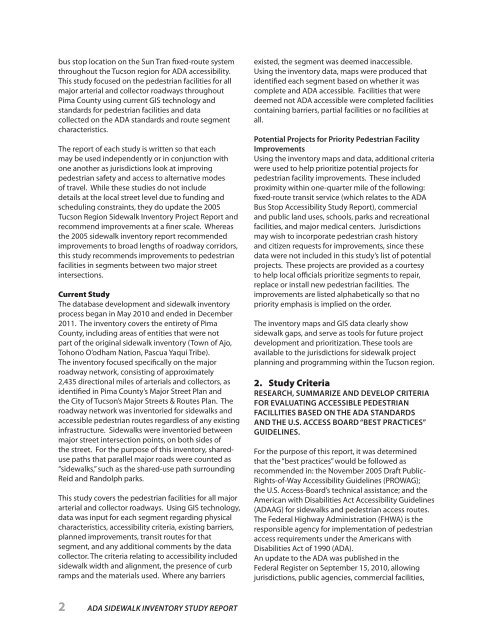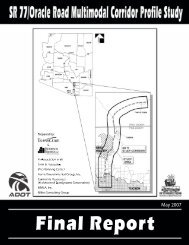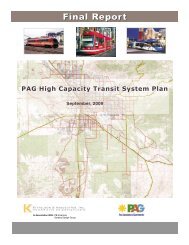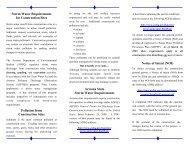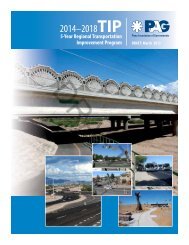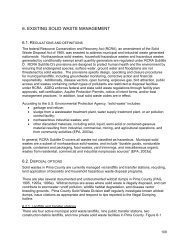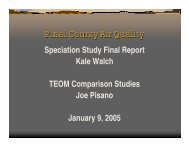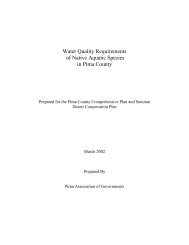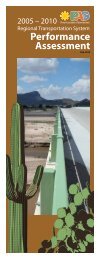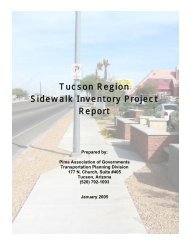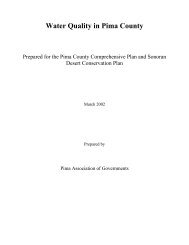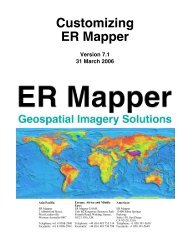2012 Sidewalk Inventory Report - Pima Association of Governments
2012 Sidewalk Inventory Report - Pima Association of Governments
2012 Sidewalk Inventory Report - Pima Association of Governments
Create successful ePaper yourself
Turn your PDF publications into a flip-book with our unique Google optimized e-Paper software.
us stop location on the Sun Tran fixed-route system<br />
throughout the Tucson region for ADA accessibility.<br />
This study focused on the pedestrian facilities for all<br />
major arterial and collector roadways throughout<br />
<strong>Pima</strong> County using current GIS technology and<br />
standards for pedestrian facilities and data<br />
collected on the ADA standards and route segment<br />
characteristics.<br />
The report <strong>of</strong> each study is written so that each<br />
may be used independently or in conjunction with<br />
one another as jurisdictions look at improving<br />
pedestrian safety and access to alternative modes<br />
<strong>of</strong> travel. While these studies do not include<br />
details at the local street level due to funding and<br />
scheduling constraints, they do update the 2005<br />
Tucson Region <strong>Sidewalk</strong> <strong>Inventory</strong> Project <strong>Report</strong> and<br />
recommend improvements at a finer scale. Whereas<br />
the 2005 sidewalk inventory report recommended<br />
improvements to broad lengths <strong>of</strong> roadway corridors,<br />
this study recommends improvements to pedestrian<br />
facilities in segments between two major street<br />
intersections.<br />
Current Study<br />
The database development and sidewalk inventory<br />
process began in May 2010 and ended in December<br />
2011. The inventory covers the entirety <strong>of</strong> <strong>Pima</strong><br />
County, including areas <strong>of</strong> entities that were not<br />
part <strong>of</strong> the original sidewalk inventory (Town <strong>of</strong> Ajo,<br />
Tohono O’odham Nation, Pascua Yaqui Tribe).<br />
The inventory focused specifically on the major<br />
roadway network, consisting <strong>of</strong> approximately<br />
2,435 directional miles <strong>of</strong> arterials and collectors, as<br />
identified in <strong>Pima</strong> County’s Major Street Plan and<br />
the City <strong>of</strong> Tucson’s Major Streets & Routes Plan. The<br />
roadway network was inventoried for sidewalks and<br />
accessible pedestrian routes regardless <strong>of</strong> any existing<br />
infrastructure. <strong>Sidewalk</strong>s were inventoried between<br />
major street intersection points, on both sides <strong>of</strong><br />
the street. For the purpose <strong>of</strong> this inventory, shareduse<br />
paths that parallel major roads were counted as<br />
“sidewalks,” such as the shared-use path surrounding<br />
Reid and Randolph parks.<br />
This study covers the pedestrian facilities for all major<br />
arterial and collector roadways. Using GIS technology,<br />
data was input for each segment regarding physical<br />
characteristics, accessibility criteria, existing barriers,<br />
planned improvements, transit routes for that<br />
segment, and any additional comments by the data<br />
collector. The criteria relating to accessibility included<br />
sidewalk width and alignment, the presence <strong>of</strong> curb<br />
ramps and the materials used. Where any barriers<br />
existed, the segment was deemed inaccessible.<br />
Using the inventory data, maps were produced that<br />
identified each segment based on whether it was<br />
complete and ADA accessible. Facilities that were<br />
deemed not ADA accessible were completed facilities<br />
containing barriers, partial facilities or no facilities at<br />
all.<br />
Potential Projects for Priority Pedestrian Facility<br />
Improvements<br />
Using the inventory maps and data, additional criteria<br />
were used to help prioritize potential projects for<br />
pedestrian facility improvements. These included<br />
proximity within one-quarter mile <strong>of</strong> the following:<br />
fixed-route transit service (which relates to the ADA<br />
Bus Stop Accessibility Study <strong>Report</strong>), commercial<br />
and public land uses, schools, parks and recreational<br />
facilities, and major medical centers. Jurisdictions<br />
may wish to incorporate pedestrian crash history<br />
and citizen requests for improvements, since these<br />
data were not included in this study’s list <strong>of</strong> potential<br />
projects. These projects are provided as a courtesy<br />
to help local <strong>of</strong>ficials prioritize segments to repair,<br />
replace or install new pedestrian facilities. The<br />
improvements are listed alphabetically so that no<br />
priority emphasis is implied on the order.<br />
The inventory maps and GIS data clearly show<br />
sidewalk gaps, and serve as tools for future project<br />
development and prioritization. These tools are<br />
available to the jurisdictions for sidewalk project<br />
planning and programming within the Tucson region.<br />
2. Study Criteria<br />
RESEARCH, SUMMARIZE AND DEVELOP CRITERIA<br />
FOR EVALUATING ACCESSIBLE PEDESTRIAN<br />
FACILLITIES BASED ON THE ADA STANDARDS<br />
AND THE U.S. ACCESS BOARD “BEST PRACTICES”<br />
GUIDELINES.<br />
For the purpose <strong>of</strong> this report, it was determined<br />
that the “best practices” would be followed as<br />
recommended in: the November 2005 Draft Public-<br />
Rights-<strong>of</strong>-Way Accessibility Guidelines (PROWAG);<br />
the U.S. Access-Board’s technical assistance; and the<br />
American with Disabilities Act Accessibility Guidelines<br />
(ADAAG) for sidewalks and pedestrian access routes.<br />
The Federal Highway Administration (FHWA) is the<br />
responsible agency for implementation <strong>of</strong> pedestrian<br />
access requirements under the Americans with<br />
Disabilities Act <strong>of</strong> 1990 (ADA).<br />
An update to the ADA was published in the<br />
Federal Register on September 15, 2010, allowing<br />
jurisdictions, public agencies, commercial facilities,<br />
2 ADA SIDEWALK INVENTORY STUDY REPORT


